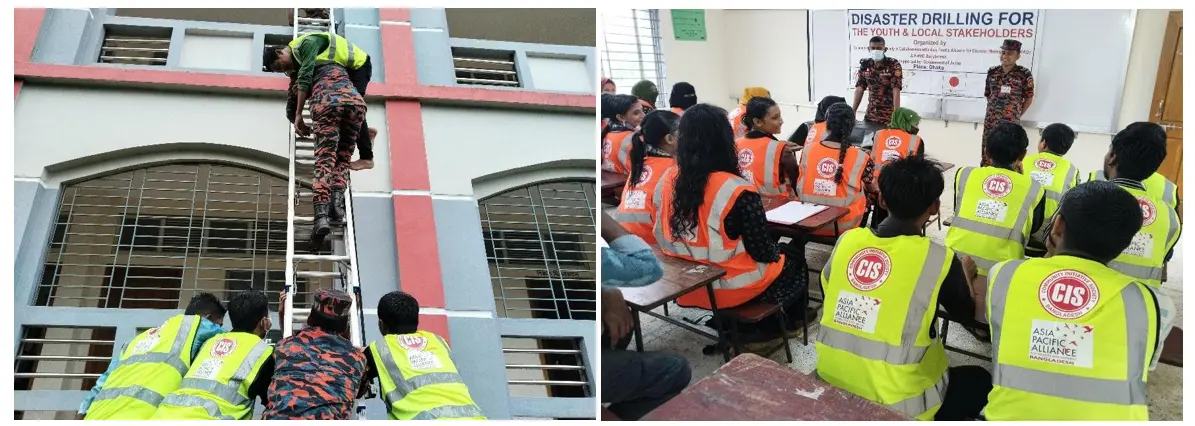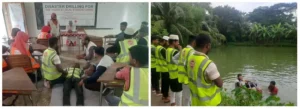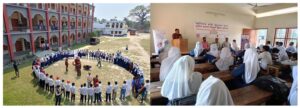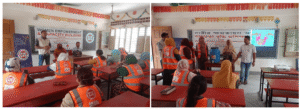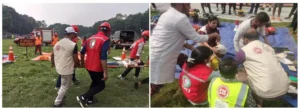Project Title: Strengthening Capacity for Sustainable Disaster Management Network by involving multi-sectoral platform Project Period: 17 January, 2024– 16 January, 2025 (12 month)
- Project Activities and Accomplishments
Bangladesh’s historical narrative, both before and after its independence, is heavily influenced by a range of disasters, largely driven by natural hazards. Situated near the Bay of Bengal, the nation faces the frequent threat of tropical cyclones that originate in the Indian Ocean. These powerful storms intensify as they approach the Southeast Asian region, with Bangladesh being one of the most affected countries. Storms are the most common disaster type encountered by the nation and have historically caused widespread devastation. The geographical makeup of Bangladesh, characterized by its extensive river delta systems and a monsoon climate, significantly heightens the risk of flooding. These floods rank as the second most common disaster affecting the country, often exacerbated by storm surges associated with cyclones. In addition to these challenges, Bangladesh is also vulnerable to landslides that typically occur in the wake of storms and heavy rainfall, alongside other hazards like earthquakes, extreme temperatures, and widespread epidemics that can arise in the aftermath of such disasters. The impacts of climate change are becoming increasingly apparent, further exacerbating Bangladesh’s susceptibility to these hazards.
A-PAD Bangladesh initiated its project in January 2023, with ongoing efforts continuing from January 17, 2025, aimed at enhancing capacity in disaster management. The organization engages with various sectors, including local communities, community leaders, stakeholders, and government officials, through continuous training sessions focused on disaster management. To facilitate these training programs, A-PAD Bangladesh staff organized small community meetings to share insights on disaster preparedness and to introduce participants to the activities of A-PAD Bangladesh. The organization operates across eight divisional areas.
In each division, there is one health worker responsible for conducting home visits to raise awareness within the local community regarding fundamental disaster management issues. These health workers also disseminate crucial information concerning government directives or any disaster-related announcements to the community. As of August 2025, A-PAD Bangladesh has successfully benefited a total of 3,456 individuals.
A-PAD Bangladesh also participated in coordination meetings held in the eight divisions at the Office of the Deputy Commissioner. These meetings included various NGOs that presented their activities and discussed future initiatives in collaboration with government bodies and NGO partners.
1. Strengthening of disaster risk reduction and disaster response system functions through the Emergency Disaster Management Coordination Center | ||
Activities | ( Outcome 1 ) The Emergency Disaster Management Coordination Center operated under this project will function as a disaster response base in each region, leading to the disaster risk reduction in the community and the strengthening of its disaster response system.: | Project Status: Achievements vs Outcome: If the activity is behind the schedule, please write the reason. |
1-1 Operation of Emergency Disaster Management Coordination Centers Target:Local communities 10 people×25 days×8 divisions×12 months =24,000 people | 【Indicators of Outcome】 1-1 The Emergency Disaster Management Coordination Center will be used for coordination meetings among partner organizations and relevant stakeholders during normal times, and will also serve as a center for health and public health guidance for the local residents. In the time of emergency, health services will be provided by emergency health workers. The Emergency Disaster Management Coordination Center will be used by 24,000 local residents (annual average) in the target area. (Indicator:number or visitors, record of services provided)
1-2 Through the Disaster Management Awareness Program, community residents will receive the latest disaster information and knowledge on how to respond to disasters, and people’s awareness of disaster prevention and response will be increased. (Indicator:Community disaster preparedness report) | Total 2,456 people visited to the Disaster Management Coordination Center to discuss about disaster preparedness and health related issues. Dhaka: 290 Persons Cox’s Bazar: 285 Persons Pabna: 320 Persons Bagerhat: 298 Persons Patuakhali: 325 Persons Habiganj: 318 Persons Rangpur: 309 Persons Netrokona: 311 Persons Total = 2,456 Persons |
1-2 Disaster Management Awareness Program Target:Local communities, Community leaders, Local NGOs, Private company workers, government officials 15 people × 8 divisions × 4 times ×12 months =5,760 | A-PAD Bangladesh conducted Disaster Management Awareness programs at the 8 divisional areas where 491 persons have participated. Total 4 times training organized at each divisional areas. Dhaka:15 Participantsx 4 Sessons= 60+2=62 Participants Cox’s Bazar: 15 Participantsx 4 Sessons= 60+3=63 Participants Pabna: 15 Participantsx 4 Sessons= 60+1=61 Participants Bagerhat: 15 Participantsx 4 Sessons= 60 Participants Patuakhali: 15 Participantsx 4 Sessons= 60+2=62 Participants | |
people |
| Habiganj: 15 Participantsx 4 Sessons= 60+2=62 Participants Rangpur: 15 Participantsx 4 Sessons= 60+1=61 Participants Netrokona: 15 Participants x 4 Sessons= 60 Participants |
2. Expansion of disaster management network to improve community vulnerability | ||
| (Outcome 2)The network of NPF will be expanded and the capacity of each region for disaster prevention and response will be strengthened. |
|
2-1 Network Partner Meeting Target : Local communities, Community leaders, Local NGO, Private Company Workers, Government officials 50 people × 5 villages × 8 divisions = 2,000 people | 【Indicator of Outcome】 2-1 Strategies, mechanisms, and action plans for disaster reduction cooperation are developed in each region through discussions at network partner meetings, and a framework for disaster reduction cooperation is established. (Indicator:Strategic Plan) 2-2 MOUs signed with at least 5 new organizations, including private companies, in A-PAD Bangladesh NPF to expand the network (Indicator:number of new MOUs signed) 2-4 Resources possessed by A-PAD BGD partner organizations are provided in emergency disaster response, and play the role of that organization in times of emergency. (Indicator:List of resources such as supplies, human resources and donations provided by partner organizations for emergency disaster response) | A-PAD Bangladesh organized Network Partner Meeting at Bagerhat. Total 256 Participants joined the Network Partner Meeting. 10 August 2025, Golbuniya, Total Participants 50 Participants 11 August 2025, Dhanshagor, Total Participants 50 Participants 12 August 2025, Jilbunia, Total Participants 50+2=52 Participants 13 August 2025, Bogi, Total Participants 50 Participants 14 August 2025, Lakurtala, Total Participants 50+4=54 Participants Participants highlighted the critical importance of timely and accurate early warning systems as a means to mitigate disaster risks. The discussions underscored the need for improved communication channels to ensure rapid outreach to vulnerable communities. There was a consensus that technology, alongside community volunteers, could significantly enhance the effectiveness of early warning systems. Concerns regarding the potential for disease outbreaks during and following disasters were a major focal |
|
| point. Partners shared valuable insights and experiences in managing waterborne diseases and responding to epidemics in the aftermath of disasters. Strategies for vaccination campaigns and hygiene promotion initiatives were thoroughly discussed.
Furthermore, the role of technology emerged as a transformative element in disaster preparedness and response. Key topics included the implementation of mobile applications for emergency alerts, GIS mapping for risk assessment, and telemedicine services. Participants expressed their commitment to promoting the use of digital tools within vulnerable communities. Leaders and volunteers from grassroots organizations—including neighborhood associations, youth groups, women’s collectives, and religious institutions—were recognized for their essential contributions in mobilizing communities, raising awareness, and executing localized disaster management strategies. The meeting also illuminated the necessity of integrating health sector strategies with disaster preparedness frameworks. Participants concurred that maintaining separate plans often leads to confusion during emergencies. Consequently, establishing integrated plans would facilitate improved coordination and optimize resource utilization. |
2-2 Disaster Preparedness Campaigns Target:Partner organizations and local communities 50 people × 2 times × 8 divisions = 800 people |
|
|
2-3 Network Partners Capacity Strengthening (DRR) Target : Partner organizations 20 people × 2 organizations × 2 times × 8 divisions = 640 people | A-PAD Bangladesh conducted Networking Partner Capacity Strengthening DRR at Bagerhat and Rangpur where 45 persons have participated from 2 Organizations. 20-21 August 2025, Bagerhat, Total 40 Participants 20-21 August 2025, Bagerhat, Total 40+4=44 Participants
Networking Partners Capacity Strengthening in Disaster Risk Reduction (DRR) Training can contribute significantly to the development of an Integrated Disaster Preparedness and Reduction Plan. This initiative encourages collaboration among non-governmental organizations (NGOs), government agencies, and beneficiaries, extending its impact beyond Bagerhat to encompass the entire country.
The primary objective of Disaster Risk Reduction (DRR) is to mitigate the damage caused by natural hazards such as earthquakes, floods, droughts, and cyclones, emphasizing a proactive approach to prevention. DRR is fundamentally about making informed choices; it involves systematic efforts to analyze and minimize the factors that contribute to disaster risk. Key strategies include reducing exposure to hazards, lessening the vulnerability of individuals and communities, |
|
| effectively managing land and environmental resources, and enhancing preparedness for adverse conditions.
Innovative and flexible methodologies were employed throughout the training sessions, particularly given the challenges posed by the rainy season. Special attention was dedicated to ensuring the availability of health equipment, workshop materials, and the participation of skilled individuals. Efforts were made to create an engaging and interactive training environment, fostering active participation from attendees. The facilitators demonstrated adaptability, responding to participant feedback and taking local contexts into account during the training program.
Capacity strengthening initiatives among network partners in Bangladesh have significantly improved disaster response coordination, heightened community preparedness through comprehensive knowledge and skill development, and reinforced institutional frameworks for disaster risk reduction (DRR). These efforts have facilitated collaboration among government entities, non-governmental organizations, and community stakeholders, thereby empowering local populations. Additionally, they have refined early warning systems and fostered an environment that prioritizes resilience, ultimately contributing to a reduction in mortality rates and enhancing Bangladesh’s leadership role in disaster |
|
| risk reduction. In light of these advancements, it is essential to |
conduct a comprehensive assessment of the current capacity | ||
and knowledge gaps among our network partners in DRR. This | ||
will inform the design of a tailored curriculum that addresses | ||
the identified needs, with a strong emphasis on key DRR | ||
principles and alignment with the objectives of the National | ||
Plan for Disaster Management. To ensure effective learning | ||
outcomes, it is recommended to employ a variety of interactive | ||
training methods that encourage participant engagement and | ||
promote a collaborative learning atmosphere. | ||
2-4 Seminar for Developing New Disaster Prevention Solutions Target : NGO, Disaster | A-PAD Bangladesh conducted Seminar at Cox’s Bazar and Rangpur where 33 persons have participated. 24-25 August 2025, Rangpur, Total Participants 30+4= 34 Participants | |
prevention related government organizations, Private sector personnels 30 people ( 2days ) × 8 | 27-28 August 2025, Cox’s Bazar, Total Participants 30+2= 32 Participants
Natural disasters inherently disrupt the fabric of everyday life, | |
divisions × 2 times = 480 people | and Bangladesh is particularly susceptible to such events. It is imperative to adopt realistic and long-term strategies to | |
| effectively address all forms of disasters, necessitating | |
| collaboration between government agencies and non- | |
| governmental organizations. Developing various voluntary | |
| organizations at the local level is crucial for enhancing | |
| community resilience. Given that natural disasters impact the | |
| nation as a whole, it is essential for all stakeholders to unite |
|
| with a collective determination to mitigate the effects of these events. By doing so, we can more effectively address post- disaster challenges and minimize potential damages. Specifically, disaster management is about organizing and directing resources to cope with a disaster and coordinating the roles and responsibilities of responders, private sector organizations, public sector agencies, nonprofit and faith-based organizations, volunteers, donations, etc. The ultimate goal of the disaster-management leader is to minimize the event’s impact, something that involves preparedness, response, recovery and mitigation.
Specifically, disaster management is about organizing and directing resources to cope with a disaster and coordinating the roles and responsibilities of responders, private sector organizations, public sector agencies, nonprofit and faith-based organizations, volunteers, donations, etc. The ultimate goal of the disaster-management leader is to minimize the event’s impact, something that involves preparedness, response, recovery and mitigation. Implementing an evacuation plan in a school, for example, showing teachers how to lead students to safety in the event of a tornado or fire. Planning and designing a city in a way that minimizes the risk of flooding, for example, with the use of locks, dams or channels to divert water away from populous areas. Preparedness is an ongoing process in which individuals, communities, businesses and organizations |
|
| can plan and train for what they’ll do in the event of a disaster. Preparedness is defined by ongoing training, evaluating and corrective action, ensuring the highest level of readiness. |
2-5 International Symposium on DRR
Target : Government, Local government, private company, NOG, partner organization, representative of A-PAD member countries, etc. 200 people |
| |
4. Practical training to improve resilience of local communities | ||
| ( Outcome 3 ) Contribute to improving the disaster resilience of local communities through practical training. |
|
3-1 Disaster response capacity building of local community level in Health and hygiene field | 【Indicator of Outcome】 3-1 a) Establish networks of community leaders who can lead disaster response and emergency health response in all districts of Bangladesh. (Indicator:Number and the List of community leaders for disaster response/emergency health in each 8 districts.) b) Networks of human resources with the skills and know-how to respond to |
|
3-1 a) Workshop on Disaster Management and Emergency Health Response
Target : Local residents, | A-PAD Bangladesh conducted Workshop on Disaster Management and Emergency Health Response at Dhaka where 28 persons have participated.
19-20 August 2025, Dhaka, Total Participants 25+3=28 Participants | |
Community leaders, Local NGO workers 25 people ( 2 days ) × 8 divisions × 2 times = 400 people | health emergencies will be established in all districts of Bangladesh to provide health services to the local residents in times of emergency. (Indicator:Data of NGO health personals who can respond in emergency. Number of residents who received the services in the cases of activities during emergency disaster in each 8 districts.)
3-2 a) Disaster preparedness training and drills will be documented in a manual, and women, youth groups, and local stakeholders who participate in the drills will be granted certificates of completion and work as disaster volunteer teams during actual disasters. (Indicator:Drilling Manual, Cases of activities in emergency disaster response) b) Disaster drills at junior high schools will be documented in a manual so that students who participate in the drills will have the skills to take appropriate action in the event of a disaster. (Indicator:Drilling Manual, Report of emergency disaster response) | The seminar is designed to convene experts, practitioners, and policymakers across various sectors to exchange knowledge and experiences in disaster prevention and management. It serves as a platform for participants to discuss the latest research findings, best practices, and innovative solutions within the field. The objectives of the seminar include promoting collaboration and partnerships among diverse stakeholders, such as disaster management agencies, non- governmental organizations (NGOs), academics, engineers, architects, and urban planners. By fostering dialogue and cooperation, the seminar aims to identify new opportunities for collaboration and innovation. Additionally, the seminar seeks to explore novel approaches and technologies that can enhance disaster prevention and management. By recognizing and developing effective strategies and policies, the seminar aspires to contribute significantly to the advancement of disaster prevention efforts. |
3-1 b) Training of Local Health Workers on Disaster Health Activities
Target : Health workers who belong to local NGOs or civil organizations 20 people ( 3 days ) × 8 divisions = 160 people | A-PAD Bangladesh conducted Local Health Workers training at Barhatta where 24 persons have participated.
12-14 August 2025, Barhatta, Total Participants 20+2=22 Participants
For geographic location and weather condition, cyclone, tidal flood, erratic Health Risks Reduce, CIS Barhatta provided a training of Local Health Workers on Disaster Health Activities |
|
| that focus on basic safety measures as part of internal safety and precaution to carry out activities in daily life. Extensive trainings have been conducted to Familiarizes staff with the general symtoms of Dengue and preventive measures such as keeping house clean and Tidy Not to leaving stagnant water lying anywhere in or around the house. CIS conducted a training program in Barhatta, Netrakona on 12-14 August- 2025, Three days of training. The trainer Emphasized on Symtoms of dengue, severe dengue is an emergency and requested the participants to Recognizes the warning Signs. He added that if anyone develop any one of these warning signs to go to a local clinic or emergency room immediately. And the Discussion on Maternal and Child Health Care. Next discussed on Diarrhoea which is characterized by abnormally loose or watery tools. Most cases of Diarrhoea are due to bacteria, viruses or parasites. Digestive system disorder can also cause chronic Diarrhoea. CIS is playing an important role by creating awareness program and conducting such training, seminar and worksop on disaster reduction. CIS taken an initiative steps during disaster and assisted with emergency support to the vulnerable people including incidents of fire in the villages of Barhatta. |
3-2 Strengthening disaster response capacities of local communities through disaster drilling training |
|
3-2 a) Women Empowerment and Capacity Building
Target : Women’s groups in target villages 20 people ( 2 days ) × 8 divisions × 2 times = 320 people |
| A-PAD Bangladesh conducted Women Empowerment and Capacity Building at Pabna and patuakhali where 22 persons have participated. 09-10 August 2025, Pabna, Total Participants 20+4=24 Participants 13-14 August 2025, Galachipa, Total Participants 20+2=22 Participants The Pabna district, located in Bangladesh, is notably susceptible to various disasters, including floods, earthquakes, thunderstorms, excessive rainfall, and fires. Recognizing the critical need for preparedness and response strategies, a comprehensive training workshop was organized to enhance emergency response capabilities during and after such disasters. On August 9 and 10, 2025, the Community Initiative Society (CIS) facilitated a two-day training program titled “Women Empowerment and Capacity Building” in Pabna. This initiative brought together a diverse group of 20 participants, comprising local community members, community leaders, school teachers, and representatives from local non- governmental organizations (NGOs). The training workshop were discussed Women empowerment and how to increase their capabilities. Nasrin Parvin Executive Director at Suchita Samaj Unnoyan Sanstha about this matter. Also speaking Community initiative society (CIS) medical. Question session was arranged in the training workshop and feedback was |
|
| received from them. |
The training session emphasized the critical importance of | ||
recognizing cyclone warning signals. Participants learned about | ||
the various stages of cyclone alerts, how to interpret these | ||
signals effectively, and the protocols for seeking immediate | ||
shelter during severe weather events. Detailed guidance was | ||
provided on proactive preparations to undertake prior to a | ||
disaster striking, which included gathering non-perishable food | ||
items, ensuring an adequate supply of clean drinking water, | ||
and assembling vital documents. In light of the community’s | ||
vulnerability to river erosion and potential storm surges, the | ||
program included comprehensive swimming lessons tailored | ||
specifically for women. These sessions covered foundational | ||
swimming techniques to promote safety in water as well as | ||
practical rescue methodologies. | ||
3-2 b) Disaster Drilling for the Youth and Local Stakeholders Target:Youth in the local | A-PAD Bangladesh conducted Youth and Local Stakeholder Drilling at Bagerhat and Pabna where 95 persons have participated.
13-14 August 2025, Dhaka, Total Participants 45+2=47 | |
private and civic sector 45 people ( 2 days ) × 8 | Participants 13-14 August 2025, Patuakhali, Total Participants 45+3=48 | |
divisions × 2 times = 720 people | Participants CIS Dhaka conducted Two day Disaster Drilling for the Youth |
|
| and Local Stakeholders training at South Kurushkul Model High School. 30 participants had joined the Disaster Drilling for the Youth and the stakeholders training in each day. Besides, Dhaka districts one of the disaster prone areas and often experienced by various natural calamities including cyclones, landslides, flashfloods fires etc. These natural disaster effects on life and livelihood. Despite being a disaster-prone area, the people has lack of preparedness and awareness to deal with these disasters. In this relation, On 1st day of the training, He said that this types of demonstration by volunteers can safe life and livelihood if disaster happen. He also said that “awareness and preparedness can reduce the damage caused by disasters,’.He thanked CIS for organizing such event. The Station Officer of Fire Service and Civil defense thanked the Government of Bangladesh and the organization those who working for DRR and said that Bangladesh is making remarkable progress in disaster management. |
3-2 c) Disaster Drilling for Junior High Schools Target:School Children 40 people ( 2 days ) × 8 divisions × 2 times = 640 people |
| |
3-3 Update website contents as E-resources | https://apad-bd.org/a-pad-bangladesh-activity-report-month- of-july-2025/ |
- Challenges
Practice in collaboration with A-PAD Bangladesh Network Partners Please write good practice in collaboration with partner organizations
- Any contribution Funds Received and Grants Applied / Planned and Implemented Projects by CIS including Emergency Response
Please write Projects name and its fund resources
Relationship with Bangladesh Government and Japanese Embassy Please write about Meeting with Government office

